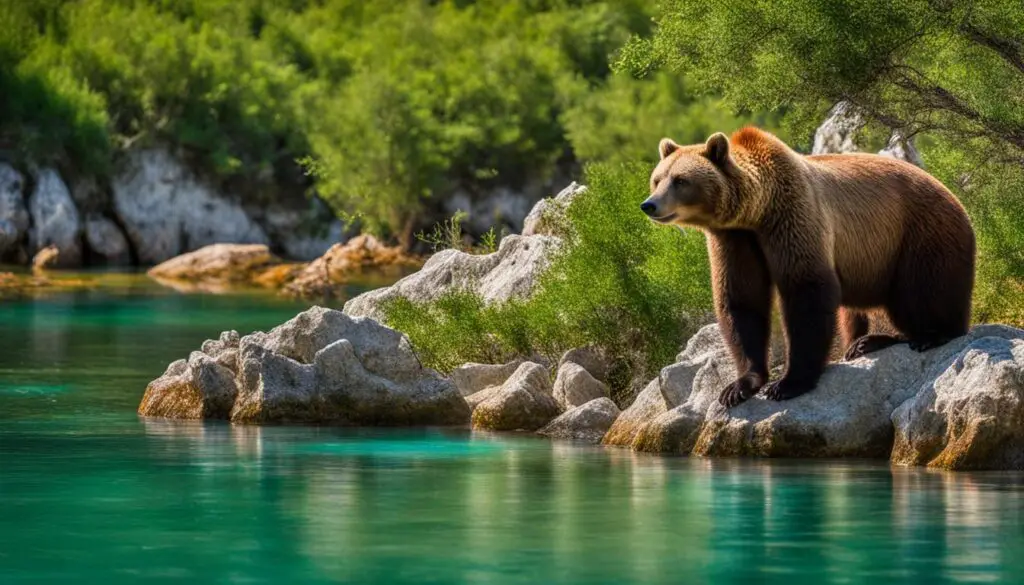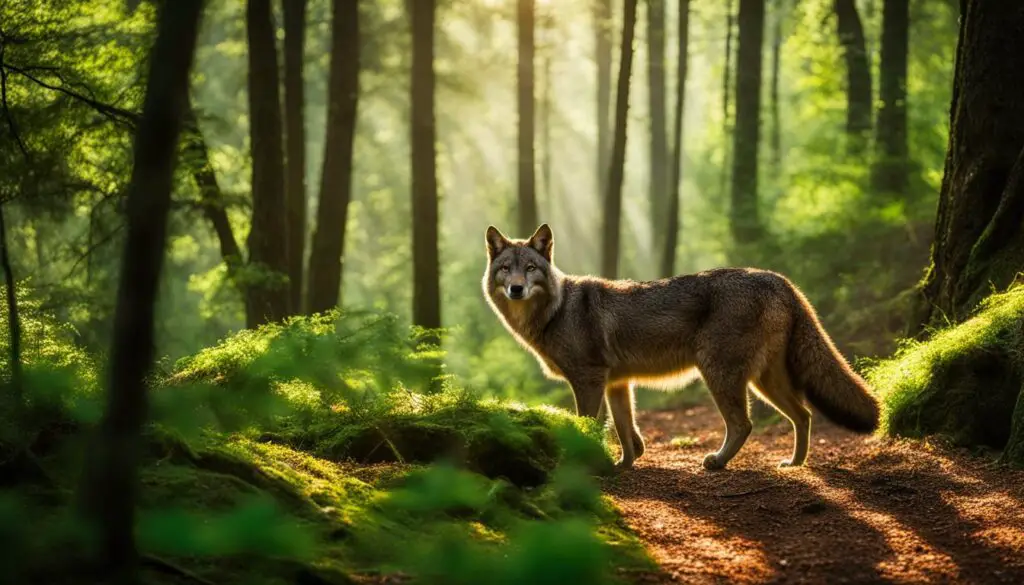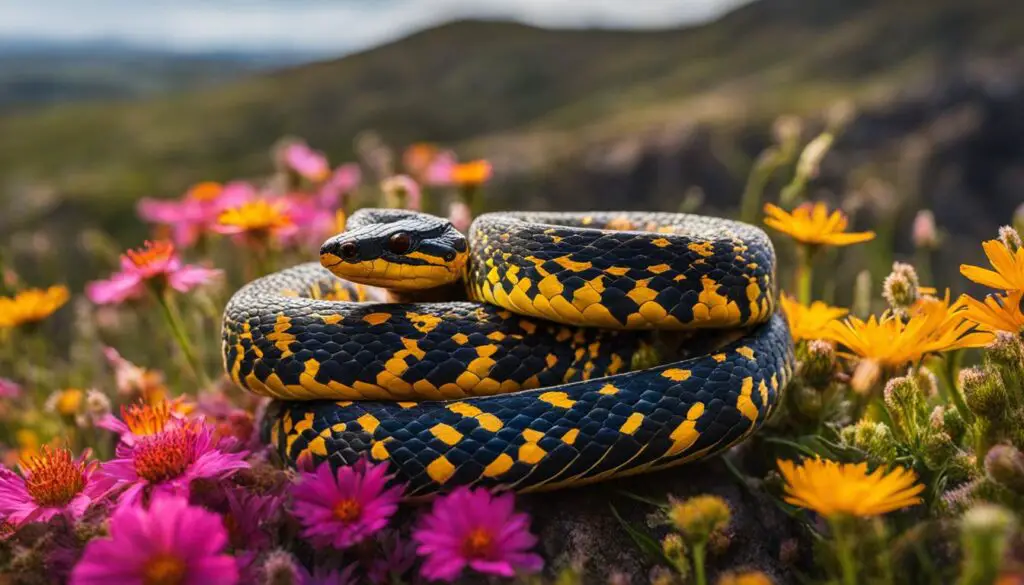Croatia, a small U-shaped country in Southeastern Europe, is renowned for its diverse fauna and thriving conservation efforts. With over 237 tracked animal species, Croatia boasts a wide variety of wildlife thriving in its diverse landscapes. From lowland territories to mountains, forests, and coastal regions, every corner of the country offers a habitat for fascinating creatures.
Among the notable animal species found in Croatia are wolves, bears, foxes, wild boars, weasels, wild cats, reptiles, and a myriad of marine life. These animals find sanctuary in Croatia’s more than 400 protected areas, which encompass approximately 9% of the country’s land. These protected areas include national parks, reserves, and nature parks, each playing a crucial role in biodiversity preservation and conservation efforts for animals in Croatia.

Key Takeaways:
- Croatia is home to over 237 tracked animal species.
- The diverse landscapes of Croatia provide habitats for animals such as wolves, bears, foxes, and wild cats.
- The country’s protected areas cover approximately 9% of its land and include national parks, reserves, and nature parks.
- Conservation efforts are vital for preserving the rich biodiversity of animals in Croatia.
- Visitors have the opportunity to observe wildlife and contribute to conservation efforts in national parks like Plitvice Lakes, Paklenica, and Risnjak.
Croatia’s National Animals: European Pine Marten and Common Nightingale
In Croatia, the European pine marten, known as “kuna zlatica” in Croatian, holds the esteemed title of the country’s national animal. This small mammal is not only a symbol of Croatian wildlife but also carries historical significance in the country’s economic history. The silky pelt of the European pine marten was once used as a form of currency in Croatia.
The European pine marten can be found in various national parks across Croatia, such as Papuk Nature and Plitvice Lakes. These protected areas offer a glimpse into the natural habitat of this remarkable creature. With its slender body, pointed snout, and bushy tail, the European pine marten is a fascinating sight for wildlife enthusiasts.
Alongside the European pine marten, the common nightingale proudly holds the position of Croatia’s national bird. This migratory songbird is admired for its melodious and captivating song. After spending the winter in West Africa, the common nightingale makes its way to Europe during spring and summer.
Its arrival heralds the beginning of warmer months, and its enchanting melodies fill the Croatian countryside. The common nightingale can be spotted in various natural habitats, including forests, woodlands, and parks.
Protected Habitats and Endangered Species in Croatia
Croatia takes great pride in its commitment to preserving and protecting its diverse wildlife. The country is home to several protected habitats, including eight national parks and numerous reserves and nature parks. These areas serve as crucial sanctuaries for a wide range of endangered species and contribute to the conservation efforts in Croatia.
Among the notable protected habitats in Croatia are Plitvice Lakes National Park, Paklenica National Park, and Risnjak National Park. These parks not only offer breathtaking natural landscapes but also provide habitats for a variety of wildlife species. Visitors to these parks have the opportunity to observe animals such as brown bears, lynxes, wild cats, wolves, eagles, and owls in their natural environments.
However, Croatia faces challenges in safeguarding its endangered species. The country is actively working to protect and conserve animals such as the Mediterranean Monk Seal, Olm, Eurasian Lynx, Dalmatian Turtle, Eurasian Beaver, and Eurasian Wolf. These species require dedicated conservation efforts to ensure their survival and the preservation of Croatia’s rich biodiversity.
Conservation initiatives play a vital role in safeguarding the protected habitats and endangered species in Croatia. Through collaboration between government organizations, local communities, and environmentalists, concerted efforts are being made to protect and restore these habitats and raise awareness about the importance of preserving Croatia’s wildlife.
In conclusion, protected habitats in Croatia serve as havens for endangered species, and the country’s conservation efforts are crucial for preserving its diverse fauna. By recognizing the significance of these habitats and supporting conservation initiatives, Croatia ensures a sustainable future for its wildlife and maintains its status as a biodiversity hotspot.

Venomous Snakes and Spiders in Croatia
In the diverse fauna of Croatia, there are several venomous snakes and spiders that visitors should be aware of. These creatures may pose a threat if encountered, but with proper precautions, you can safely explore the beautiful landscapes of Croatia.
One venomous snake that inhabits Croatia is the Horned Viper. This snake, also known as the European Sand Viper, is one of the most dangerous venomous snakes in Europe. It can be found in rocky hillsides across the country. Although encounters with this viper are rare, its venom can cause severe symptoms if bitten.
The Common European Viper, with its distinctive zigzag pattern, is widely distributed in Croatia and responsible for the majority of snake bites in the country. While its bite is venomous, it is rarely life-threatening if immediate medical attention is sought.
Another venomous snake to be cautious of is the Meadow Viper. This snake, found in grasslands and meadows at higher elevations, can deliver a venomous bite. As with all venomous snakes, it is important to keep a safe distance and avoid provoking them.

In addition to venomous snakes, Croatia is also home to the European Black Widow Spider. Although exceptionally rare, encounters with this venomous spider can result in a painful bite. While the venom of the European Black Widow Spider is potent, cases of death are extremely uncommon.
When exploring the wilderness of Croatia, it is essential to stay cautious and informed about the native wildlife. By respecting the natural habitat of these venomous snakes and spiders, you can ensure a safe and enjoyable experience in this beautiful country.
Croatia’s Largest Animals and Flag Symbolism
Croatia is home to some of Europe’s most fascinating wildlife, including the impressive Eurasian brown bear, which holds the title as the largest animal in the country. With a population of approximately 900, these magnificent creatures primarily inhabit the dense forests, particularly the groves of beech and fir found in the stunning Dinaric Alps and Gorski Kotar regions. The Eurasian brown bear’s presence adds to the diverse and thriving fauna of Croatia.
Another remarkable animal found in Croatia is the Eurasian Lynx, known for its elusive nature and stunning beauty. Unfortunately, due to various challenges, the Eurasian Lynx is now classified as the rarest animal in the country. Found primarily in Gorski Kotar, this magnificent feline’s population is threatened by factors such as a lack of genetic variation, poaching, and collisions with vehicles. Conservation efforts are vital to safeguard the future of this extraordinary species and preserve Croatia’s rich biodiversity landscape.
Aside from its impressive wildlife, Croatia’s flag holds significant symbolism. The colors featured on the flag represent the historical kingdoms of Croatia, Dalmatia, and Slavonia. The central element of the flag is a shield checkered in red and white, bearing resemblance to the original flag of the Kingdom of Croatia. This cherished symbol serves as a reminder of the nation’s vibrant history and cultural heritage.
FAQ
What kinds of animals can be found in Croatia?
Croatia is home to a wide variety of animals, including wolves, bears, foxes, wild boars, weasels, wild cats, reptiles, and marine life.
How many protected areas are there in Croatia?
Croatia boasts more than 400 protected areas, including national parks, reserves, and nature parks, covering approximately 9% of its land.
Where can visitors observe wildlife in Croatia?
Remarkable places for wildlife sightings in Croatia include Plitvice Lakes National Park, Paklenica National Park, and Risnjak National Park.
What are some endangered animal species in Croatia?
Endangered animal species in Croatia include the Mediterranean Monk Seal, Olm, Eurasian Lynx, Dalmatian Turtle, Eurasian Beaver, and Eurasian Wolf.
Which venomous snakes can be found in Croatia?
Croatia is home to venomous snakes such as the Horned Viper, Common European Viper, and Meadow Viper.
Are there any venomous spiders in Croatia?
Yes, the European Black Widow Spider can be found in Croatia, although cases of death from its bite are exceptionally rare.
What is the largest animal in Croatia?
The Eurasian brown bear is the largest animal in Croatia, with a population of about 900.
Where can the Eurasian Lynx be found in Croatia?
The Eurasian Lynx can be found in Gorski Kotar, but its population is threatened due to various factors.
What does the Croatian flag symbolize?
The Croatian flag represents the colors of the kingdoms of Croatia, Dalmatia, and Slavonia, with a shield checkered in red and white representing the original flag of the Kingdom of Croatia.
